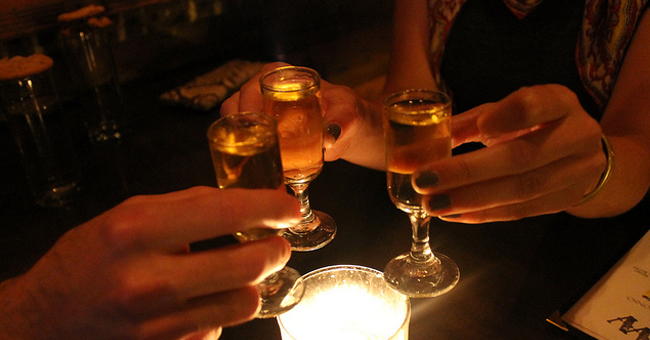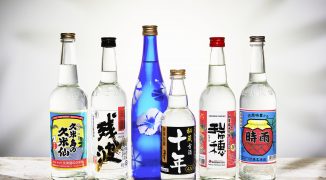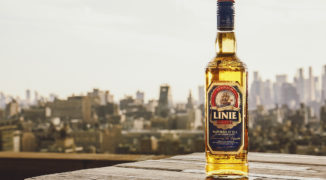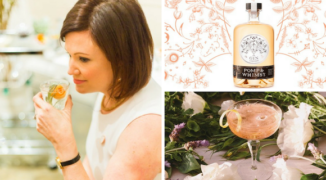It’s a tale as old as time: man drinks a traditional drink, brings it with him to his new home, begins making it himself, sells the recipe to local distillery and pretty soon, well, it’s behind every bar in town. At least, that’s the story of Carl Jeppson, the man behind Chicago’s favorite love-to-hate-it, love to trick your friends from out of town with it liqueur, Jeppson’s Malört.
Jeppson’s Malört still has a spot on just about every back bar in town, but it’s increasingly joined, or at some joints even replaced, by house-made varieties that draw inspiration from the spirit’s Scandinavian roots. (To clarify: “malört,” with a lowercase “m”, means wormwood in Swedish; “Malört,” with a capital “M” is often used as a shorthand reference to the Jeppson’s stuff. Finally, “besk”—spelled phonetically—or “bäsk” means bitter in Swedish. Drawing inspiration from these varietals, some bars, such as Fat Rice, crafts their own in-house version, while distillers like FEW Spirits, Letherbee and DALA Spirits are riffing with their own iterations.
The Letherbee version, called Bësk, began when Robby Haynes, former bar manager at The Violet Hour (and now a partner at Letherbee), was out drinking with a friend and scribbled out an idea on a napkin. The next day he called his friend, Letherbee founder Brent Engel, and that was that.
“We had a really clear vision as to what we wanted it to taste like from the start,” says Haynes. “Honey was in play as a potential sweetener for a moment. It looked good on paper but it muddled the palate so we nixed it.” Beyond that trial and error, Haynes says the biggest challenge was scaling up the recipe for production.
Fortunately, the bar was on board. “[The Violet Hour] was really supportive of this whole project and the first 50 cases or so were exclusively available at the bar,” says Haynes. “Our buddy Nick Pyle drew this crazy wizard and we had some labels printed up. The reception was overwhelming and people seemed genuinely stoked on the whole thing. Bottles started showing up in other cities within a couple of weeks.”
Originally labeled as malört, Letherbee changed the name to Bësk after some controversy over the name.
“Thankfully, since then, we’ve actually been selling much more,” says Engel. “We love that some people are so passionate about these products that they are deemed worthy of debate. Language can be an abstract thing and our perspective is simple. If someone goes to a bar and orders Letherbee ‘malört,’ the bartender typically understands what the customer is asking for. We don’t take offense. We just hope that people enjoy it, no matter what they want to call it.”
The Violet Hour carries both ‘their’ Letherbee version as well as Jeppson’s, and likes to mix them into the cocktails for which they’re well-known. Bartender Tyler Fry prefers Bësk for mixing in cocktails and Jeppson’s for shooting. He likes to pair Bësk with citrus flavors, honey, anise, gin, Campari, Chartreuse, pineapple… the sky’s the limit.
“[T]hese flavor combinations lend themselves to doing it as a sour, doing it as a smash, doing it as a swizzle, you could just sort of Mr. Potato Head them in and out,” says Fry.
Jeppson’s Malört is available in Chicago, the surrounding areas, Wisconsin and, strangely enough, in Maryland. It can also be purchased online through Chicago retailer Binny’s Beverage Depot if legal to ship to your state. Letherbee Bësk is more widely available.
Jeffrey Moll, head barman at Randolfi’s in St. Louis, has used Bësk in his cocktails for about as long as it’s been available to him. He says it’s not as difficult of a sell in St. Louis as it maybe would have formerly been.
“I’ve always told people it’s more amiable [laughs]. Where Jeppson’s is very dry and bitter and aggressive and kind of punchy, I feel like Bësk is a little more bright and it kind of has that sensation like it’s mentholated or like Vick’s Vapo-Rub or lemon verbena, you know, like a little [brighter] and… nicer,” said Moll.
DALA Spirits’ Bäska Snaps is distilled in Iceland, and is intended to be a more traditional Scandinavian bitter liqueur. It’s bitter, but doesn’t (and shouldn’t) have the rep for being as intolerable as Jeppson’s.
“It’s something that’s consumed as an aperitif, digestif and as a palate cleanser: something that’s traditionally knocked back in small amounts to cleanse your palate of strong oily flavors that are so predominant in Scandinavian cuisine [like] sour creams, butter, cured fish and caviar,” says Avery Glasser, CEO and co-founder of DALA Spirits (as well as Bittermens and Bittermens Spirits). “We make an aquavit with citrus, rhubarb and licorice, then we blend in distilled wormwood and a touch of sugar. It’s bitter, but refreshing. It works beautifully with pineapple and rum.”
“We aren’t trying to create something that’s intentionally hard to drink, nor something that needs to be consumed as a dare,” he adds.
FEW Spirits’ bitter wormwood liqueur is called, appropriately, Anguish & Regret. FEW founder Paul Hletko says that, while sharing similar roots, the spirit has little in common with the flavor of Jeppson’s.
“I think they each have their own unique characters, different people like one better than the others,” he says. “Ours is more perfume-y, a little bit more flavorful than other malörts. It certainly doesn’t taste anything like the Jeppson’s.”
As for whether malört will ever achieve popularity outside of Chicago? “I have no idea,” says Hletko. “It’s certainly relatively popular here in Chicago, but I think it can be a little bit challenging to get the love for malört outside of Chicago that we have here. I think it should be, but the consumer doesn’t necessarily agree with us,” he says.
In Logan Square, Fat Rice makes their own version of a malört liqueur, but without the addition of any actual wormwood. The lauded Macanese restaurant infuses local vodka with Indian and Chinese-style bitter melon, ‘local’ Wisconsin ginseng and reishi mushrooms for their take on the cult classic. Like The Violet Hour, one of the ways that they like to use it is in their version of a white Negroni, where it’s paired with gin, white vermouth and another house-made liqueur, this one made from trifoliate lemons.
“And we, of course, being in Chicago, really like it in shot form,” says beverage director Annie Beeb-Tron. “You can’t help that.”
Still, the true-blue Jeppson’s following remains strong in Chicago. That’s the one you’re going to order for your out-of-town friend who has no idea what they’re getting themselves into. And lots of locals truly, genuinely enjoy it. Local food truck Bad Day Donuts serves up a specialty donut called The Lorax, which features Malört as part of the glaze, and Logan Square gin joint Scofflaw has Jeppson’s on tap.
“The reason that we decided to put Malört on tap is because the four of us loved the camaraderie that we felt it represented and helped facilitate,” says Danny Shapiro, head bartender and partner at Scofflaw. “I mean, it is really cool. Everyone remembers their first Malört shot… it’s a hard thing to forget.”
Brad Bolt, general manager at West Town bar Bar DeVille, also has a soft spot for Jeppson’s. “It’s the original. I mean, it’s the original and all their packaging, their branding, none of it’s throwback, it’s just never changed,” Bolt said. “I only carry the Jeppson’s, just because, [when] we opened this bar, it was the only one that was available and I had it the day we opened.”
“So there is, I think, some true, old-school Chicago pride to it all. Like, ‘this is ours, this has always been ours’.”





